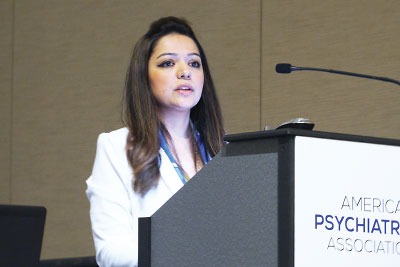Psychiatrists have a critical role in the assessment of young people at risk of school violence and can help focus interventions at early stages in the trajectory toward violence; they include the stages of grievance, violent ideation, research and planning, and pre-attack preparation.
That’s the message psychiatrists and a law enforcement official delivered at APA’s 2023 Annual Meeting in the session “Anyone Could Have Stopped Me: Early Intervention in the Trajectory of Violence.”
Drawing on an
analysis of school shootings by the U.S. Secret Service, Shanila Shagufta, M.B.B.S., a child and adolescent psychiatry fellow at Oregon Health Sciences University, noted that “one of the most striking revelations in almost all of the cases” was the failure to report behavior observed by a third-party bystander that might have led to intervention. The analysis looked at 41 incidents of targeted school violence that occurred at K-12 schools in the United States from 2008 to 2017.
“The next time you assess a patient in the ED reporting an intention to [commit violence at school], it should prompt you to evaluate where the patient is in the trajectory toward violence,” she said. “Most of the time these patients are seeing us during this early stage of preparation and ideation. These stages serve as critical intervention points to deter them from advancing on the path of violence.”
Shagufta was joined by Andrew Nanton, M.D., a child psychiatrist and forensic psychiatry expert witness at Park Dietz and Associates in Oregon; Daniel Nicoli, M.D., an assistant professor of psychiatry at Oregon Health Sciences University; and Greg Concepcion, a special agent and threat management consultant with the FBI in San Francisco.
Based on the Secret Service analysis, Shagufta said 90% of violent incidents were carried out by students enrolled in the school at the time. All were between the ages of 12 and 18, and 83% were male. Almost 70% used firearms, and 39% used bladed weapons; 31% had an arrest history, and 17% had a history of violent crimes.
Psychosocial stressors were common: disputes with romantic partners, strained relationships with peers, parental separation, domestic abuse, being bullied in front of peers, and a history of abuse and neglect. “In almost all cases, there was an acute stressor that preceded the incident,” Shagufta said.
“Risk assessment is not about predicting violence,” Nanton said. “It’s about stratifying risk”—identifying where on the trajectory of violence a youth might be and the youth’s likelihood of advancing. “Think longitudinally—you need to assess imminent risk but also the foreseeable risk of violence in the future.”
He outlined 11 key questions to think about when assessing a young person for risk of violence. The 11 items are drawn from a 2002 publication of the U.S. Department of Education and the U.S. Secret Service National Threat Assessment Center titled “
A Guide to Managing Threatening Situations and Creating Safe Schools.” These are the questions:
•
What are the student’s motive(s) and goals? What motivated the student to make the statements or take the actions that caused him or her to come to attention? What efforts have been made to resolve the problem, and what has been the result? Does the potential attacker feel that any part of the problem is resolved or see any alternatives?
•
Have there been any communications suggesting ideas or intent to attack?
•
Has the student shown inappropriate interest in weapons/mass violence?
•
Has the student engaged in attack-related behaviors (such as planning)?
•
Does the student have the capacity to carry out an act of targeted violence?
•
Is the student experiencing hopelessness, desperation, and/or despair?
•
Does the student have a trusting relationship with at least one responsible adult?
•
Does the student see violence as an acceptable, desirable, or even the only way to solve problems?
•
Is the student’s conversation and “story” consistent with his or her actions?
•
Are other people concerned about the student’s potential for violence?
•
What circumstances might affect the likelihood of an attack?
“We need to ask the hard questions that no one else feels comfortable asking,” said Nicoli. He also emphasized the vital importance of regular and clear communication with the family of an at-risk youth. Communication is especially critical when the risk of violence warrants notifying law enforcement.
“There’s only so much we can do as psychiatrists,” he said. “We treat patients; we don’t enforce laws. We need to get this in the proper hands when the risk is there.” ■

